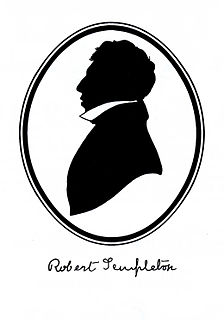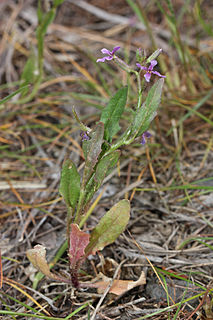
John Edward Gray, FRS was a British zoologist. He was the elder brother of zoologist George Robert Gray and son of the pharmacologist and botanist Samuel Frederick Gray (1766–1828). The standard author abbreviation J.E.Gray is used to indicate this person as the author when citing a botanical name. The same is used for a zoological name.

Albert Karl Ludwig Gotthilf Günther FRS, also Albert Charles Lewis Gotthilf Günther, was a German-born British zoologist, ichthyologist, and herpetologist. Günther is ranked the second-most productive reptile taxonomist with more than 340 reptile species described.

Robert Templeton was a naturalist, artist, and entomologist, and was born at Cranmore House, Belfast, Ireland.

Crassocephalum is a genus the common names of whose members include ragleaf, thickhead, and bologi. Several species are raised as leaf vegetables and used for medicine, especially in West Africa. Similar to Senecio, but differing in never having ray florets. A calyculus of short bracts is present. The genus is typically thistle-like in appearance, but all parts are soft and not spiny.

Sir Walter Elliot, KCSI was a British civil servant in Colonial India. He was also an eminent orientalist, linguist, archaeologist, naturalist and ethnologist who worked mainly in the Presidency of Madras. Born in Edinburgh, he studied at the East India Company College at Haileybury and joined the East India Company's civil service at Madras in 1820 and worked on till 1860. He was invested Knight Commander of the Order of the Star of India (KCSI) in 1866.

André Jean Baptiste Robineau-Desvoidy was a French physician and entomologist specialising in the study of Diptera (flies) and to some extent of the Coleoptera (beetles).

Legousia speculum-veneris, the looking glass or large Venus's-looking-glass, is an annual ornamental plant in the family Campanulaceae (bellflowers). It blooms from June to August and is native to the Mediterranean region.

Rhaphidophora is a genus in the family Araceae, occurring from tropical Africa eastwards through Malesia and Australasia to the Western Pacific. The genus consists of approximately 100 species.
Harold St. John was a professor of botany at the University of Hawaiʻi at Mānoa from 1929 to 1958. A prolific specialist in field botany and systematics, he is credited with discovering about 500 new species of Pandanus, along with many other species, especially in the Pacific Islands.

Marcel-Henri Gaussen, was a French botanist and biogeographer.

Rauvolfioideae is a subfamily of the flowering plant family Apocynaceae. Many species are woody lianas, others are shrubs or perennial herbs.

Catophractes alexandri, the only species in the genus Catophractes, is a spiny shrub or small tree up to 3m tall, belonging to the family Bignoniaceae and occurring in the hot, low-rainfall regions of Namibia, the Northern Cape, Kalahari Desert, Botswana, western Zimbabwe and Limpopo. Preferring calcrete, limestone outcrops and soils, the species often forms pure communities, or grows in association with Colophospermum mopane, Rhigozum virgatum, Phaeoptilum spinosum and Acacia nebrownii. It is parasitised by several Tapinanthus spp.

Chorispora is a genus of plant in the family Brassicaceae.

Cocculus orbiculatus, the queen coralbead, is a species of woody vines. It is found from India east to Java.
Cyclea elegans is a species of flowering plants in the family Menispermaceae. It is found in Sumatra, Malaya, Borneo. An isotype is kept at Kew Gardens Herbarium. It was collected on Mount Kinabalu Dallas.
Jasminum andamanicum is an endangered endemic wild ornamental species described in 1981 from the Andaman Islands in the Bay of Bengal from two old collections by Dr King's Collector in 1894 and another one by C. E. Parkinson in 1914 deposited at CAL and PBL. This species has not been recorded from the islands until 1991 by Mathew and Abraham from Shoal Bay. This species is an evergreen component of the lowland evergreen forests of Andaman Islands. It found to grow alonge the forest edges with ample sunlight.
John Henry Lace (1857–1918) was a British botanist.
Herbert Fuller Wernham was a British botanist, who from 1909 to 1929 worked at the British Museum, as an assistant in the Botany department. From 1911 to 1921 he published extensively on tropical plants and many genera, retiring in 1921 due to ill health (alcoholism).
Benedetto Scortechini (1845–1886) was an Italian botanist, explorer, and Roman Catholic priest.













